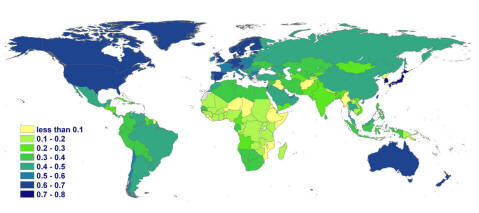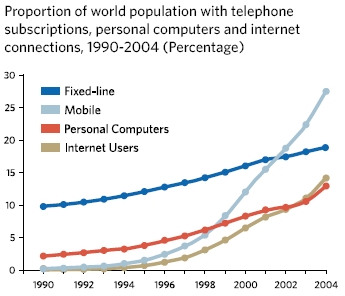By Ismael Peña-López (@ictlogist), 10 July 2006
Main categories: Connectivity, Digital Divide, e-Readiness, Hardware, ICT4D
No Comments »
New report developed by the International Telecommunication Union, the UNCTAD, the Ministry of Information and Communications of the Republic of Korea and the Agency for Digital Opportunity & Promotion (KADO).
This report charts progress towards the Information Society, in response to the call by the WSIS Geneva Plan of Action, for evaluation and international benchmarking, as well as the need for monitoring of WSIS follow-up and implementation (noted in the WSIS outcome documents). It evaluates access to telecommunications and digital opportunity in 180 economies worldwide in the context of the WSIS targets and Millennium Development Goals. It presents the Digital Opportunity Index, as called for by the WSIS Geneva Plan of Action, paragraph 28, and considers the policy implications for the further evolution of the Information Society. It reviews WSIS implementation and follow-up in different countries, and considers efforts to promote ICT development. It also presents the latest available data on 180 economies worldwide.
It is intended that the “The World Information Society Report” will be an annual publication.
So, it seems that the transition from the Digital Access Index and the Digital Opportunity Index has been done. Nevertheless, looking at who is backing the new report and, hence, the DOI, I guess there’s still some time until the Partnership on Measuring ICT for Development becomes really functional. I suppose it’s likely that next edition will be signed by the Partnership in its whole.

Digital Opportunity Index 2005. Source: World Information Society Report 2006
[click to enlarge]
The main two reflections that come to mind — besides the most evident about the digital divide and wealth distribution/opportunity-to-access in the world — are:
- There’s a urgent need to stablish an index covering the whole range of the digital divide and not just infrastructures: digital literacy, content and services use and policy, legal framework.
- Disturbing content and Diverted to bad sites stands for only 7% of the greatest online fears, being cibercrime (in its many faces) up to 91%. This makes me think about the unbalanced efforts made in censorship apps, filters and regulation by paternalist Governments in front of the real needs as perceived by users.
By Ismael Peña-López (@ictlogist), 05 July 2006
Main categories: Development, ICT4D
1 Comment »
The Millennium Development Goals Report 2006 has just been released and the main conclusion is “well… errrr… we’ve not accomplished almost anyhting… some things have indeed worsened… but, hey, let’s give a positive and optimist message that there’s some change to move into the right path”.
Concerning ICT’s and ICT4D it is evident that, actually, there’s an increasing adoption of these technologies at all levels:

Proportion of world population with telephone subscriptions, personal computers and internet connections, 1990-2004 (Percentage). Source: Millennium Development Goals Report 2006
But I’m “glad” to read that:
[there is] a large digital divide separating developed and developing
regions: Over half the population in developed regions had access to the Internet, compared to 7 per cent in developing regions and less than 1 per cent in the 50 least developed countries.
Of course I’m not “glad” to read that there is a digital divide, but that at least someone recognizes it exists and, regardless of the fact that in relative terms the divide has decreased, in practical terms it is so huuuuuuge that shame on you for sticking to righteous-and-oh-so-formally-correct statistical data interpretation. This is something I wrote about in my post World Telecommunication/ICT Development Report 2006: digital divide narrowing?
and feel comforted to see that I’m not the only one looking at it this way.
By Ismael Peña-López (@ictlogist), 14 March 2006
Main categories: Development
No Comments »
Looking for some information on the MDG, I found plenty of “official” sites. Being unable to discriminate the best amongst them, here they go:
If this list updated, that’ll happen in the Millennium Development Goals page in the ICT4D Wiki.
By Ismael Peña-López (@ictlogist), 08 January 2006
Main categories: Setup
2 Comments »
For those few reading these lines besides me, I do hate make you lose your time with stuff not strictly related to this blog’s purpose – and your purpose in reading it.
BUT
I wonder if some news lately might not be of “public” interest, even if they’re just to contextualize this and everything. Excuse me too for the catchy title of this entry – read on to see where does it come from.
Since December 1st I left my responsibility leading the Cooperation for Development Programme at the Open University of Catalonia. This is something we had been cooking since… almost February 2005 together with one vice-president and the CEO of the University. The reason of it all was that the Cooperation for Development Programme was leading some projects that should be lead within the framework of an academic strategy, say, from a Faculty. These projects where the direction of two masters in development, three (and a half) knowledge transfer international projects, research and innovation (almost)projects, etc.
After some internal benchmarking we found that the Faculty of Law and Political Science was deeply interested in launching an area of knowledge centered in Public Policies for Development (including ICT4D). The who’s and how’s were debated since April 2005 until October 2005, when the University decided I would become professor at the Faculty of Law and Political Science leading this new “area”, which would include the academic projects that were formerly run by the University’s Cooperation for Development Programme. Just because of bureaucracies it all was officialized last December 1st.
This means that this blog will, presumably, turn into something more academic and be shifting from e-learning and online volunteering to issues more centered in policies and the digital divide. Previous subjects will not be – of course! – forgotten, but my (somehow) new professional interests seem to be joining my late personal interests and thus scope would be a little bit wider and a little bit deeper at the same time. I guess in the following posts that’ll get some clearer.
BTW, (at least) two other ICT4D people are trying to face new challenges this new year. Jayne Cravens and Andy Carvin are leaving their actual projects and are available – the former I know, the second I guess – to share their valuable knowledge. Have good luck in your quests!
By Ismael Peña-López (@ictlogist), 20 July 2005
Main categories: Education & e-Learning
No Comments »
Just gathering info…
Just remember that
The Sakai Project is a community source software development effort to design, build and deploy a new Collaboration and Learning Environment (CLE) for higher education.
[…]
The Sakai Project has its origins at the University of Michigan and Indiana University, where both universities independently began open source efforts to replicate and enhance the functionality of their existing CMSs . Soon after, MIT and Stanford joined in and, along with the Open Knowledge Initiaitive (OKI) and the uPortal consoritum, and a generous grant from the Mellon Foundation, they formed the Sakai Project.
By Ismael Peña-López (@ictlogist), 03 May 2005
Main categories: Setup
No Comments »
I’ve always had on my About Me section my e-mail address so I could be contacted. And I had it there as an image to avoid spam. This was ugly and not accessible.
I’ve just fixed it adding a new Contact section where there’s a form that sends me an e-mail. Better looking and much more accessible.
And pretty easy to get it done by using the code I found here.
 Full Report (8.5 Mb)
Full Report (8.5 Mb) Executive Summary (600 Kb)
Executive Summary (600 Kb) Map of Digital Opportunity Worldwide, 2005 (2.7 Mb)
Map of Digital Opportunity Worldwide, 2005 (2.7 Mb)


